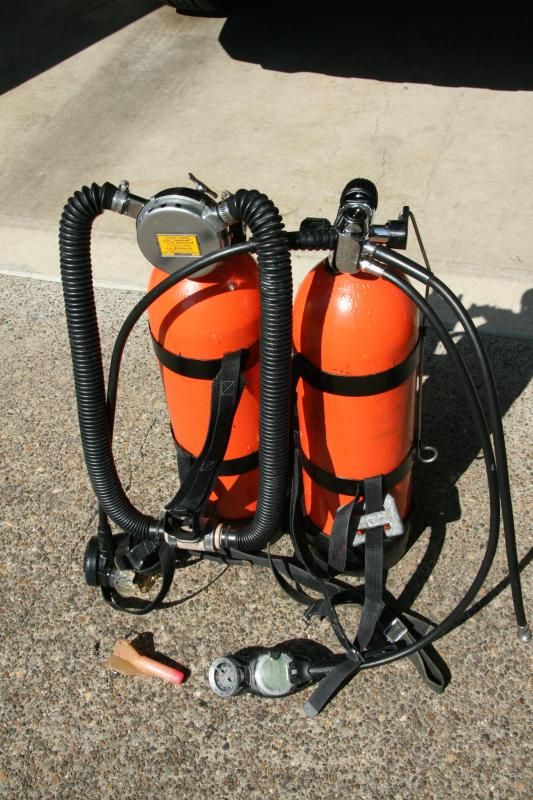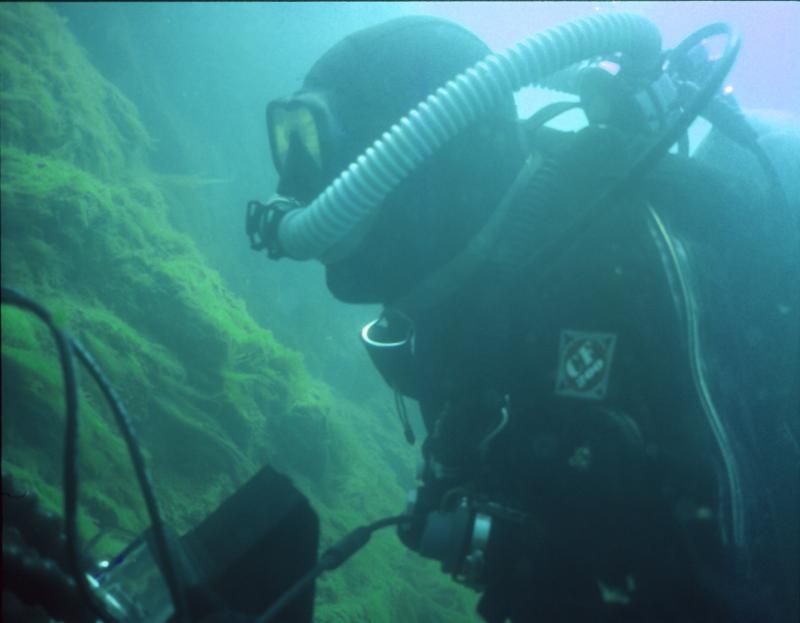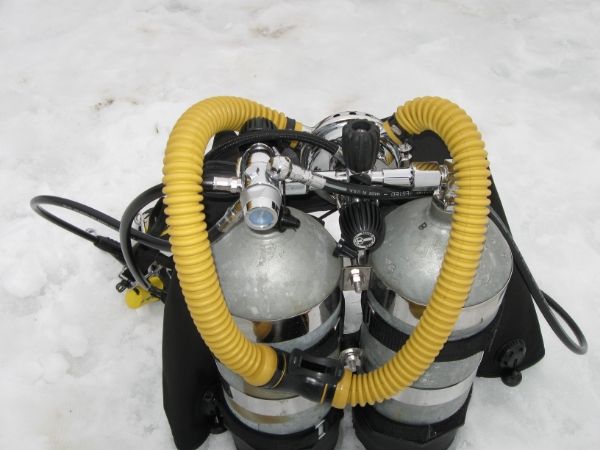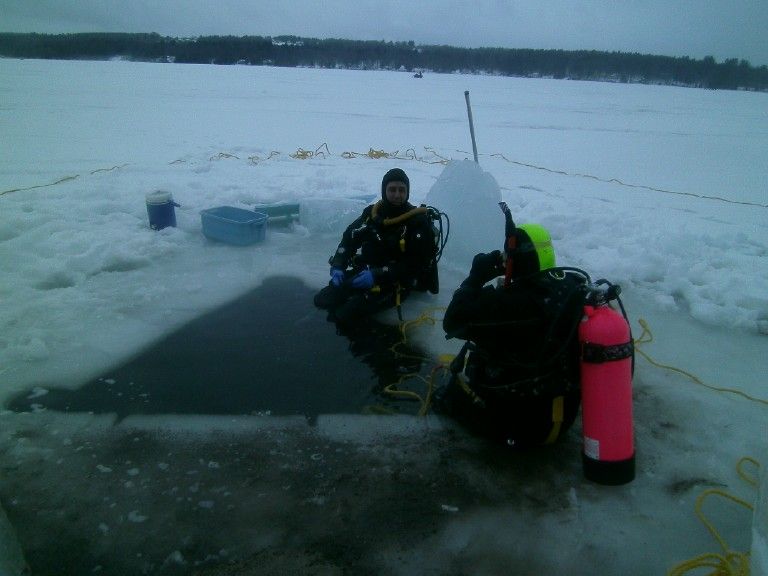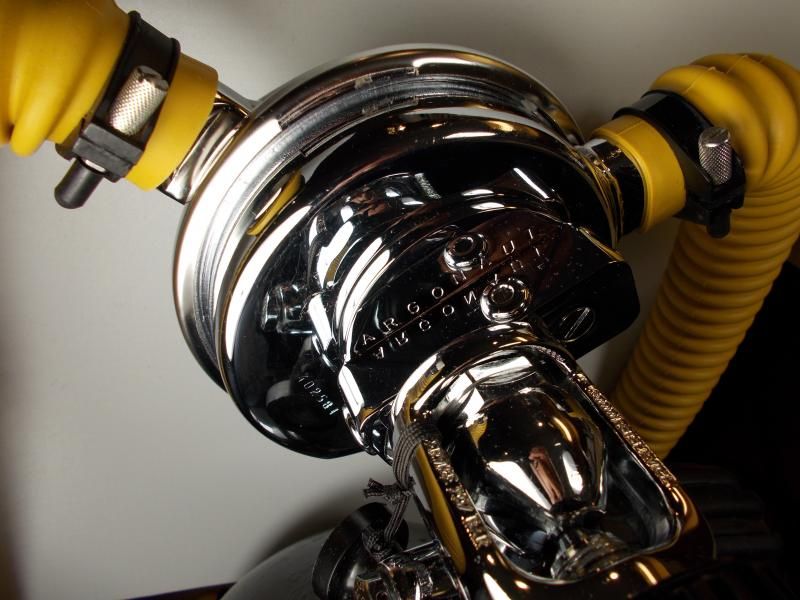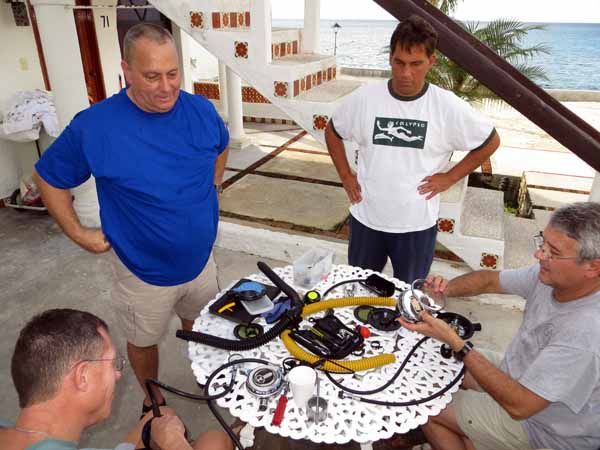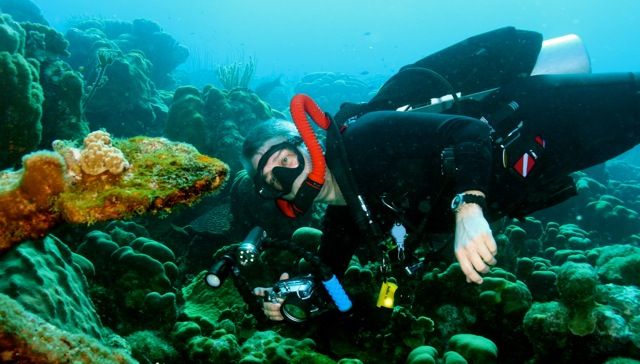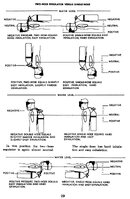Regulator Position
We all agree that regulator position is very important to the cracking effort and breathing performance, but only the relative vertical position is what matters for pressure differential in the water column. Horizontal position is totally irrelevant. Therefore, if a diver’s tank was truly horizontal in the normal swimming position, the tank and regulator location on the divers back would make no difference.
The reality is (from many observation, etc.) that the most common swimming position (even for technical divers) includes a slight slope on the scuba cylinders. By observation and measuring pictures (of even the most stringent technical diver) I have seen a slope that rages from as low as 5 degrees to many as close to 15 degrees. In these observations, I am not counting the “bad form” from over-weighted divers that have to constantly kick in a highly sloped posture to keep from sinking to the bottom. I am only referring to divers with neutral buoyancy, but in a comfortable swimming position looking forward. (See picture at the bottom of the next post)
At a high average of 10 degree slope, moving the regulator 2 inches on the divers back towards his feet translates into a vertical displacement of 0.34 inches (this is just basic trigonometry). I picked 2 inches because that is the maximum range difference that I have measured between the height (of the valve outlet) from a single tank valve to a set of vintage double tank manifold. I took these measurements on different valves and manifolds using the top of the tank neck as the reference datum line.
So I agree that it makes a slight difference, but we can easily reach points of diminishing return.
As I mentioned the effect in water column pressure differential is only affected by the vertical location in the water column. Therefore, far more important than the position down the divers back is that the regulator needs to be touching the divers back. Of course, small diameter tank/ tanks help a lot with that. More in this subject later.
BTW John, those center outlet double manifolds are vintage and not readily available to the modern double hose diver. This thread is about a totally modern regulator with strong vintage roots and I would like to keep the thread relevant to diving with modern gear. Bringing up vintage knowledge and diving style is relevant information, but those manifolds are not modern and most modern divers may not going to be interested in setting up a small set of double. If you want to discus this further, could you please start a new thread. Thanks
I also found it interesting that you posted pictures of your double with two of the worst performing double hose of all time (The Dacor and the Trieste). Yes, I am aware that you have done a lot of modifications and work on them, but really...

I have regularly adjusted the cracking effort on an Argonaut to a very stable and very repeatable 0.1 to 0.2 inWC, but obviously I have to detune to about 0.5 to 0.6 inWC for actual diving (that is the radius of the exhaust valve). I have not come across a regulator to date that can be adjusted to that low of a cracking effort, with that precision, stability, reliability, and repeatability. Again, because of the diameter of the exhaust valve it is not practice to tune it to anything less than 0.5 inWC, because it will developed a small free flow in some diver position (when the top edge of the exhaust is higher than the center of the diaphragm).
The Argonaut designed to optimize performance by bringing the regulator closer to the divers back and lower in the water column.
When I started designing the Argonaut decided to start with a mostly clean sheet of paper (actually CAD drawing and 3D model). I say mostly, because I obviously have a strong influence of 43 years of experience working with a number of different regulator designs.
One of the early decisions that involved trade-offs was how much did I want the regulator to stick-out away from the tank. The more it sticks out the closer it get to the divers back therefore better performance, but more chances of interference with some existing back-plates, backpacks, and BC’s.
I didn't have to think about it too long to decide that I wanted a double hose regulator that performed the best possible even if it wasn't compatible with some BC's in the market. I designed the regulator for performance, not for a mass market.
As a mater of fact, Bryan had some resistance to selling the regulator with a DIN adapter, because the adapter made the regulator stick out further from the tank, it did not look good and makes it more susceptible to damage if dropped. At first I agreed until I saw that a number of the DIN valves were mounted on very large fat tanks. In that situation the DIN fitting has the advantage of bringing the regulator close to the divers back (actually touching) where it belongs.
The Phoenix experience
Almost 10 years ago when I designed the Phoenix I was not very happy with the space/ length that the Phoenix needed to be, in order to have all the ports and meet all the other design limitations. It was like most things a very calculated compromise between all the requirements.
During the first redesign I was able to shorten it by 0.1 inches, but it was still relatively long.
The flip side is that it brought it close to the divers back and it could be positioned to perform great with the proper back-plate.
The experience with the Phoenix pointed to the need for a double hose specific back-plate to enhance performance, but that it could work with modern gear.
The back-plate
Almost 4 years ago, I decided that we needed a new simple back-plate made specifically for a double hose regulator. I liked the concept of the US Divers "Dog Bone" backpack, but I wanted something simpler and easier to make. I also had a simple Seacraft back-plate that was simple, but wasn't going to work with modern BC bladders and used large metal hose clamps to attach to a tank.
I decided to make my own design similar to the Seacraft in that it uses a simple flat plate, but I had to modify just about all the dimensions to fit the modern needs (BC wings, modern tank bands, etc.).
The new backplate has two set of slots to accommodate most BC wings available in the market. I designed it to use modern tank bands and the same 2 inch webbing used by all modern back-plates. The original Seacraft backplate also used two inch webbing, but I changed the method of attachment and the actual location of attachments to provide a more comfortable location (for lower backplate placement).
I also used the crossed shoulder straps to add lateral stability (so that it holds the top of the tank and regulator in the correct place). That concept was also used by the Seacraft design, but I first became familiar with the concept from its used in mountaineering and alpine backpacks. It is also common in a number of modern backplates.
The backplate is only 1/8 inch thick and it allows the regulator to stick through it and touch the divers back. If properly adjusted it will place the regulator touching the back of a diver between the shoulder blades (or lower if so desired). Just as important is that with the proper well adjusted harness, it will hold the regulator in place even with an inflated BC wing attached to it. A crotch strap is important and a sternum strap can be very beneficial to hold the kit in place.
My personal backplate is adjusted to make it very comfortable and it hold the regulator touching my back in what I consider to be a perfect location. I often feel the bubbles rolling down my back when I am swimming down. I can move lower or higher, anywhere on my back that I care to place it, but I have adjusted it to where I like it.
I sometimes say that of all the double hose regulator performance improvements I have designed, the backplate can be considered one of the most significant because of the position it places the regulator.
We travel a lot on dive trips and the backplate works great with the typical rental aluminum 80 found in most dive destinations.
IMHO, the combination of the Argonaut and the backplate (with a small wing) makes an ideal modern double hose dive kit with very strong vintage roots, but with the modern advantages: a good performing (well balanced) BC, a pressure gauge attachment (or computer transmitter), air sharing octopus, and most important a great performing regulator.
Regulator position and center of pressure sensation
BTW, the pressure differential that is most critical to diver comfort is not from the regulator to the center of the diver’s lungs, but from the regulator to the center of pressure sensor center on the diver. The location where we feel pressure (according to several physicians and the researchers at NEDU) is not in the lungs but around the back of our throat, toward the top of the throat. This is the reason why in a swimmers position with your head tilted forward (to look forward), the center of pressure sensation can be perfectly level with a well position double hose regulator.
John, I realize that you are going to want to argue this point, but if you what to argue, you need to take it to NEDU and other physicians I have talked to. I am just passing the information I got when I was there. It is not just an opinion that I formed or anything like that. If you want to start a new thread on the subject, please go ahead, lets try to keep this thread related to the Argonaut.
BTW, I dove with Sid in the Tacoma, Washington area a few months ago. Super nice guy. It was my first time diving in Puget Sound. It was some great dives.
Here is a picture of Sid. Yes, he should lower that tank.
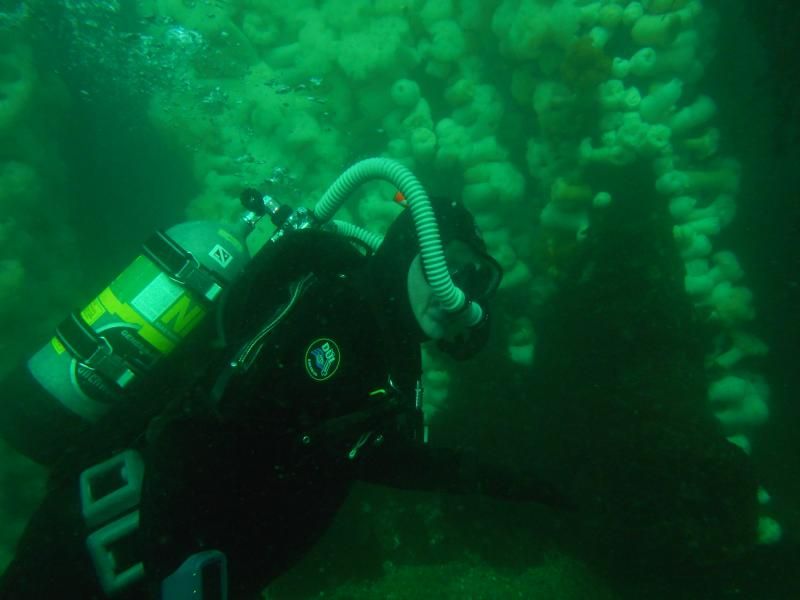
---------- Post added December 6th, 2014 at 01:04 AM ----------
Talking about the Argonaut (getting the thread back in track)
I noticed that the regulator that Couv is trying in this picture (with a DSV type mouthpiece) is my original Argonaut, one of the original four.
I wanted him to try/test the mouthpiece.
This is in Cozumel, November 2014.
That same regulator was in Cozumel in 2012 and 2013.
It was under the ice in March of 2013
It was chromed in April of 2013
It was in Roatan, Honduras, in May of 2013:
It got new cans in November of 2013 in Cozumel:
It was in Bonaire in May of 2014:
In September of 2014 it did 46 dives in the Philippines:
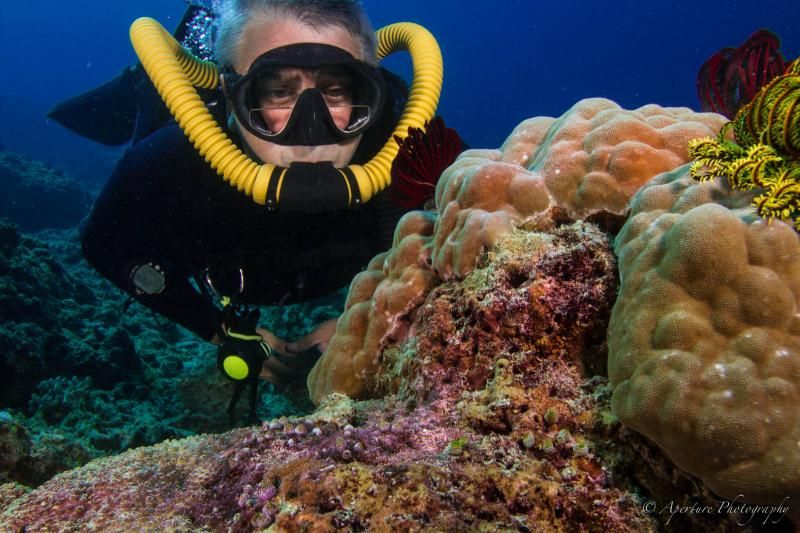
Notice in this picture in the Philippines that in my normal swimming position my tank slope is about 8 degrees.
That regulator is touching my back and at 8 degree slope it will only move about 1/8" vertically for every inch that it moves down my back.
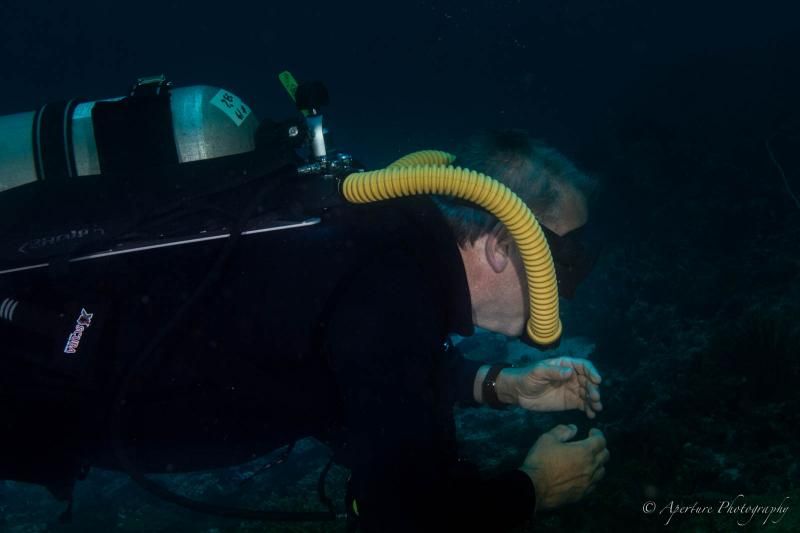
Between all this dives trips it has also done a lot of dives in the cold temperatures of Maine (and a few other cold water dives in Tacoma, Washington):

I am using the same regulator in all the pictures (some of the pictures show different hose loop).
In all this dives the regulator was only serviced once when I took it apart in March of 2013 to have it chromed. Since then it has been operating perfectly and I have no intention on servicing it for several more years.
 Can you imagine that people used to dive with those old fashioned twin hose things! The Argonaut is so sleek and modern in comparison. I am a man of the age, not a diving fossil.
Can you imagine that people used to dive with those old fashioned twin hose things! The Argonaut is so sleek and modern in comparison. I am a man of the age, not a diving fossil. If Sheldon took up SCUBA, well, you and he would have to work it out
If Sheldon took up SCUBA, well, you and he would have to work it out  .
. .
.



